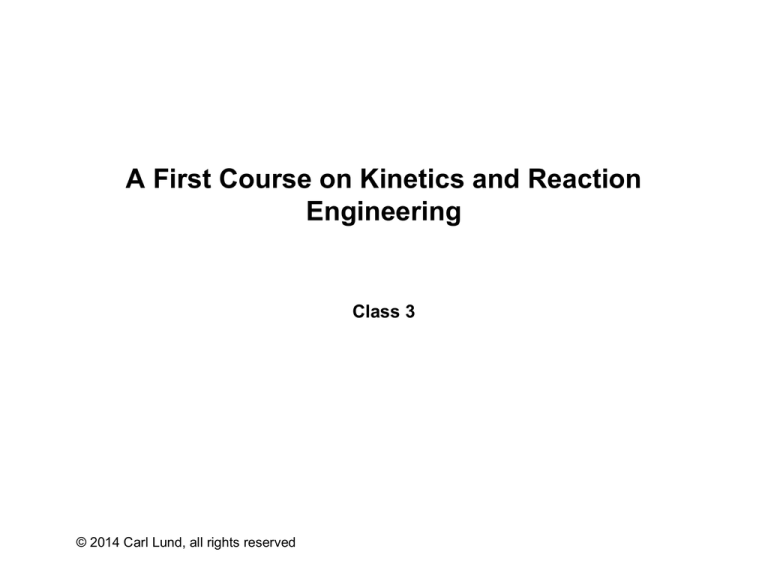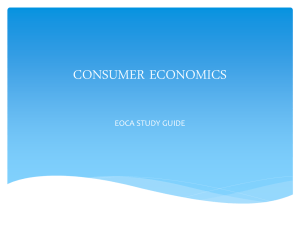
A First Course on Kinetics and Reaction
Engineering
Class 3
© 2014 Carl Lund, all rights reserved
Where We’ve Been
• Part I - Chemical Reactions
‣ 1. Stoichiometry and Reaction Progress
‣ 2. Reaction Thermochemistry
‣ 3. Reaction Equilibrium
• Part II - Chemical Reaction Kinetics
• Part III - Chemical Reaction Engineering
• Part IV - Non-Ideal Reactions and Reactors
Reaction Equilibrium
• Equilibrium constant
•
ì -DG 0j ( 298 K ) ü
‣ K ( 298 K ) = exp í
ý
j
R
298K
(
) ïþ
ïî
ì T DH 0j (T ) ü
‣ K ( T ) = K ( 298 K ) exp í
dT ý
j
j
2
ò
ïî298 K RT
ïþ
Equilibrium expression
n
‣ K (T ) = Õ a i , j
j
i
i=all
species
• Relating thermodynamic activities to composition
‣ Gases
yi P
ai =
1 atm
yij i P
ai =
1 atm
‣ Liquids
ai = xi
‣ Solids
ai = 1.0
ai = hi xi
ai = g i xi
Questions?
Water-Gas Shift Equilibrium Analysis
CO + H2O → CO2 + H2
• If a system initially contains 3 moles of H O and 1 mole of CO at 1 atm
2
and the isobaric water-gas shift reaction proceeds to equilibrium, what is
the CO conversion if the temperature is (a) 150 °C, (b) 250 °C and (c) 350
°C?
‣ The water-gas shift reaction is exothermic; predict whether the equilibrium conversion will
increase or decrease as the temperature increases
‣ In order to calculate the equilibrium composition, what equations will be used and how?
-
List the sub-tasks that need to be performed
(Create a kind of flow chart showing the equations and how they are used)
‣ What data are needed?
‣ Where can those data be obtained?
Water-Gas Shift Equilibrium Analysis
CO + H2O → CO2 + H2
• If a system initially contains 3 moles of H O and 1 mole of CO at 1 atm
2
and the isobaric water-gas shift reaction proceeds to equilibrium, what is
the CO conversion if the temperature is (a) 150 °C, (b) 250 °C and (c) 350
°C?
‣ The water-gas shift reaction is exothermic; predict whether the equilibrium conversion will
increase or decrease as the temperature increases
(
ìï - DH 0j (T ) - T DS 0j (T )
ì -DG 0j (T ) ü
K j (T ) = exp í
ý = exp í
RT
ïî RT
ïþ
ïî
-
) üï = exp ì DS
ý
ïþ
ü
ì -DH 0j ü
í
ý exp í
ý
R
RT
ïî
ïþ
ïî
ïþ
0
j
Since ΔH < 0, the second exponential will decrease as T increases, and so K will
decrease
‣ In order to calculate the equilibrium composition, what equations will be used and how?
‣ What data are needed?
‣ Where can those data be obtained?
Water-Gas Shift Equilibrium Analysis
CO + H2O → CO2 + H2
• If a system initially contains 3 moles of H O and 1 mole of CO at 1 atm
2
and the isobaric water-gas shift reaction proceeds to equilibrium, what is
the CO conversion if the temperature is (a) 150 °C, (b) 250 °C and (c) 350
°C?
‣ The water-gas shift reaction is exothermic; predict whether the equilibrium conversion will
increase or decrease as the temperature increases
‣ In order to calculate the equilibrium composition, what equations will be used and how?
-
-
Write the equilibrium expression
Calculate the value of the equilibrium constant
•
•
•
Calculate ∆G(298 K), K(298 K), ∆H(298 K)
Generate expression for ∆H(T)
Generate expression for K(T)
Express activities in terms of composition
Express composition in terms of extent of reaction
Solve for extent of reaction
Compute final composition using extent of reaction
‣ What data are needed?
‣ Where can those data be obtained?
Equations Used in the Solution
yi P
ni P
ai =
=
1 atm ntotal (1 atm )
K j (T ) =
Õa
ni , j
i
i=all
species
K1 ( T ) =
nCO2 nH 2
K1 (T ) =
nCO nH 2O
x12
( 3 mol - x1 )(1 mol - x1 )
Cˆ p,i = Ai + BiT + CiT 2 + DiT 3 + EiT -2
ìï T DH 0j(T ) üï
K j (T ) = K j ( 298 K ) exp í ò
dT ý
2
ïî298 K RT
ïþ
DH (T ) = DH ( 298 K ) +
0
j
å
i= all
species
ì -DG 0j ( 298 K ) ü
K j ( 298 K ) = exp í
ý
ïî R ( 298K ) ïþ
DG 0j ( 298 K ) =
0
j
DH 0j ( 298 K ) =
0
n
DG
å i, j f ,i ( 298 K )
i= all
species
æ
çè n i, j
ö
ˆ
C p,i dT ÷
ò
ø
298 K
T
0
n
DH
å i, j f ,i ( 298 K )
i= all
species
Alternative Solution using Element Balances
yi P
ni P
ai =
=
1 atm ntotal (1 atm )
K j (T ) =
Õa
ni , j
i
i=all
species
K1 ( T ) =
0
0
nCO
+ nCO
= nCO + nCO
2
2
2nH0 O + 2nH0 = 2nH O + 2nH
nCO2 nH 2
2
2
2
2
0
0
nCO
+ 2nCO
+ nH0 O = nCO + 2nCO + nH O
nCO nH 2O
2
2
2
2
Cˆ p,i = Ai + BiT + CiT 2 + DiT 3 + EiT -2
ìï T DH 0j(T ) üï
K j (T ) = K j ( 298 K ) exp í ò
dT ý
2
ïî298 K RT
ïþ
DH (T ) = DH ( 298 K ) +
0
j
å
i= all
species
ì -DG 0j ( 298 K ) ü
K j ( 298 K ) = exp í
ý
ïî R ( 298K ) ïþ
DG 0j ( 298 K ) =
0
j
DH 0j ( 298 K ) =
0
n
DG
å i, j f ,i ( 298 K )
i= all
species
æ
çè n i, j
ö
ˆ
C p,i dT ÷
ò
ø
298 K
T
0
n
DH
å i, j f ,i ( 298 K )
i= all
species
Water-Gas Shift Equilibrium Analysis
CO + H2O → CO2 + H2
• If a system initially contains 3 moles of H O and 1 mole of CO at 1 atm
2
and the isobaric water-gas shift reaction proceeds to equilibrium, what is
the CO conversion if the temperature is (a) 150 °C, (b) 250 °C and (c) 350
°C?
‣ The water-gas shift reaction is exothermic; predict whether the equilibrium conversion will
increase or decrease as the temperature increases
‣ In order to calculate the equilibrium composition, what equations will be used and how?
‣ What data are needed?
-
Free energies of formation of reagents at 298 K
Heats of formation of reagents at 298 K
Expressions for the heat capacities of the reagents as functions of T
‣ Where can those data be obtained?
-
Reference books
•
e, g. CRC Handbook of Chemistry
Thermodynamics textbooks
Equilibrium of Multiple Reactions Involving a Solid
• In the methanation reaction, equation (1), CO and H
are used to produce
methane, with water as a byproduct. The water that is produced can then
react with CO in the water-gas shift reaction, equation (2). In addition,
both CO and methane can decompose to form carbon as in equations (3)
and (4).
2
• CO + 3 H ⇄ CH + H O
(1)
• CO + H O ⇄ CO + H
(2)
• 2 CO ⇄ C + CO
(3)
• CH ⇄ C + 2 H
(4)
• Assuming that the carbon will form as graphite, the standard state for solid
2
2
4
(v)
2
2
(v)
2
2
4
2
carbon, and that the equilibrium constants for all four reactions are known
at the temperature of interest, develop the necessary equations and
indicate how to use them in order to determine whether it is
thermodynamically possible for carbon to form. In doing so, assume that
the system initially consists of only CO and H2 in a 1:3 (CO:H2) ratio. Ideal
gas behavior may be assumed.
Solution Process
• Assume carbon (graphite) does form
• Identify and use a mathematically independent subset of the reactions
•
•
taking place
Write equilibrium expressions for those reactions
Replace the thermodynamic activities
‣ Express activities in terms of pressure and mole fractions
‣ Express mole fractions in terms of moles
‣ Express moles in terms of initial moles and extents of the three mathematically independent
reactions
• Solve the three equations for the equilibrium extents of the three
mathematically independent reactions
‣ There may be multiple solutions
‣ If none of the solutions make sense (e. g. imaginary equilibrium extents of reaction), then
carbon does not form, i. e. the initial assumption was not valid
• If the equilibrium extents are reasonable on physical grounds, calculate
the equilibrium moles of all species
‣ If the equilibrium moles of all species are reasonable on physical grounds, this is the
equilibrium composition and carbon does form, otherwise carbon does not form
Solution Process
• Identify and use a mathematically independent subset of the reactions
taking place
‣ Only 3 of the four reactions in the problem statement are mathematically independent
-
See Supplemental Unit S1
Here you can determine mathematical independence by inspection
•
•
•
•
the first reaction is always independent
the second reaction introduces a new reagent, CO2, so it can’t be a multiple of the first
reaction
the third reaction introduces another new reagent, C, so it can’t be a linear
combination of the first two
reaction (4) = reaction (3) - reaction (2) - reaction (1)
‣ Therefore, only use reactions (1) through (3) in the analysis
• Write equilibrium expressions for those reactions
K1 =
aCH 4 aH 2O
a a
3
CO H 2
K2 =
aCO2 aH 2
aCO aH 2O
K3 =
aCO2 aC
2
aCO
K1 =
aCH 4 aH 2O
K2 =
a a
3
CO H 2
aCO2 aH 2
aCO aH 2O
K3 =
aCO2 aC
2
aCO
• Replace the thermodynamic activities
‣ Express activities in terms of pressure and mole fractions
‣ Express mole fractions in terms of mole
K1 =
æ yCH 4 P ö æ yH 2O P ö
çè 1 atm ÷ø çè 1 atm ÷ø
æ yCO P ö æ yH 2 P ö
çè
÷
1 atm ø çè 1 atm ÷ø
3
yCH 4 yH 2O æ 1 atm ö 2
=
çè
÷ø
3
yCO yH
P
æ yCO2 P ö æ yH 2 P ö
çè 1 atm ÷ø çè 1 atm ÷ø
K2 =
æ yCO P ö æ yH 2O P ö
çè
÷
1 atm ø çè 1 atm ÷ø
yCO yH 2O
yCO2 æ 1 atm ö
= 2 ç
÷
yCO è P ø
æ nCO2 ö æ nH 2 ö
çè n ÷ø çè n ÷ø
total
K 2 = total
æ nCO ö æ nH 2O ö
çè n ÷ø çè n ÷ø
total
total
æ nCO2 ö
çè n ÷ø 1 atm
æ
ö
total
K3 =
÷ø
2 ç
è
P
æ nCO ö
çè n ÷ø
total
=
2
æ nCH 4 ö æ nH 2O ö
çè n ÷ø çè n ÷ø 1 atm 2
æ
ö
total
total
K1 =
÷ø
3ç
è
P
æ nCO ö æ nH 2 ö
çè n ÷ø çè n ÷ø
total
total
nCH 4 nH 2O æ ntotal (1 atm ) ö
=
÷ø
n n 3 çè
P
CO H 2
2
æ yCO2 P ö
çè 1 atm ÷ø (1)
K3 =
2
æ yCO P ö
çè
÷
1 atm ø
=
yCO2 yH 2
nCO2 nH 2
nCO nH 2O
nCO2 æ ntotal (1 atm ) ö
= 2 ç
÷ø
nCO è
P
nCH 4 nH 2O æ ntotal (1 atm ) ö
K1 =
÷ø
n n 3 çè
P
2
K2 =
CO H 2
nCO2 æ ntotal (1 atm ) ö
K3 = 2 ç
÷ø
nCO è
P
nCO2 nH 2
nCO nH 2O
‣ Express moles in terms of initial moles and extents of the three mathematically independent
reactions
-
Note that ntotal in the equations above refers to the total moles in the gas phase
ni
It appears as a result of substituting for the gas phase mole fraction, yi =
ntotal
•
-
K1 =
It does not include the moles of C
(n
(x1 ) (x1 - x2 )
0
CO
- x1 - x2 - 2x 3 )
K2 =
(
(
æ n
3ç
0
nH 2 - 3x1 + x2 çè
)
(x2 + x3 )( nH0
2
0
CO
)
+ n - 2x1 - x 3 (1 atm ) ö
÷
÷ø
P
- 3x1 + x2
0
H2
)
0
n
( CO - x1 - x2 - 2x3 )(x1 - x2 )
(
)
0
æ nCO
+ nH0 2 - 2x1 - x 3 (1 atm ) ö
K3 =
÷
2 ç
0
ç
÷ø
P
( nCO - x1 - x2 - 2x3 ) è
(x2 + x 3 )
2
• Solve the three equations (on the last slide) for the equilibrium extents of
the three mathematically independent reactions
‣ There may be multiple solutions
‣ If none of the solutions make sense (e. g. imaginary equilibrium extents of reaction), then
carbon does not form, i. e. the initial assumption was not valid
• If the equilibrium extents are reasonable on physical grounds, calculate
the equilibrium moles of all species
nCO = n
0
CO
- x1 - x2 - 2x3
nH 2 = nH0 2 - 3x1 + x2
nCH 4 = x1
nH 2O = x1 - x2
nCO2 = x2 + x3
nC = x 3
‣ If the equilibrium moles of all species are reasonable on physical grounds, this is the
equilibrium composition and carbon does form, otherwise carbon does not form
Alternative Solution Steps
• Assume carbon does not form
• Calculate the equilibrium composition using only reactions (1) and (2)
‣ Check that they are independent
‣ Write equilibrium expressions
‣ Express activities in terms of pressure and mole fractions
‣ Express mole fractions in terms of moles
‣ Express moles in terms of initial moles and extents of the two reactions
‣ Solve the resulting equations for the equilibrium extents of reactions (1) and (2)
‣ Calculate the corresponding equilibrium moles (and mole fractions) of CO, H2, CH4, H2O and
CO2
• Write equilibrium expressions for the two carbon-forming reactions
‣ Rearrange them to calculate the activity of carbon, and do so
K3 =
K4 =
aCO2 aC
a
2
CO
aH2 2 aC
aCH 4
Þ
Þ
2
2
K 3aCO
K 3 yCO
æ P ö
aC =
=
çè
÷ø
aCO2
yCO2 1 atm
aC =
K 4 aCH 4
aH2 2
K 4 yCH 4 æ 1 atm ö
=
çè
÷ø
2
yH 2
P
‣ If the resulting activity of carbon for either reaction is greater than or equal to 1, carbon does
form and the initial assumption above is not valid
Where We’re Going
• Part I - Chemical Reactions
• Part II - Chemical Reaction Kinetics
‣ A. Rate Expressions
-
4. Reaction Rates and Temperature Effects
5. Empirical and Theoretical Rate Expressions
6. Reaction Mechanisms
7. The Steady State Approximation
8. Rate Determining Step
9. Homogeneous and Enzymatic Catalysis
10. Heterogeneous Catalysis
‣ B. Kinetics Experiments
‣ C. Analysis of Kinetics Data
• Part III - Chemical Reaction Engineering
• Part IV - Non-Ideal Reactions and Reactors









